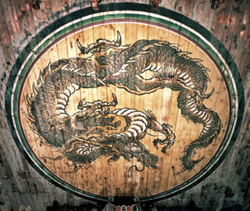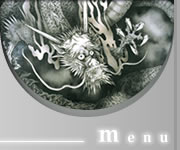Address: 701 Shokokuji Monzen-cho, Kamigyo-ku, Kyoto-shi, 602-0898 Japan
Tel: 075-231-0301; Fax: 075-212-3591
http://www.shokoku-ji.or.jp

Shokoku-ji, number two of the Kyoto Five Mountain Zen temples, was founded
in 1382 upon imperial request by Ashikaga Yoshimitsu 足利義満 (1358–1408), the
third Muromachi shogun. The construction, which was regarded as a national
project, was completed in 1392. The Zen master Shun’oku Myoha 春屋妙葩 (1311–1388)
was originally designated founding abbot, but Myoha insisted that the honor
be posthumously accorded to his own teacher, Muso Soseki 夢窓疎石 (1275–1351).
The temple was placed at the top of the Five Mountains system, and served as
a center of the Muso lineage of Zen. It suffered destruction by fire on
several occasions, first in 1394, soon after its construction (after which
Yoshimitsu helped finance its restoration), and thereafter on several
further occasions, most notably in 1425 and during the Onin Wars (1467–77),
but it managed to maintain its active role in the Zen culture of the Muromachi period.
 After the Muromachi
period it won the support of government leaders such as Toyotomi Hideyoshi
豊臣秀吉 (1536-1598), his son Toyotomi Hideyori 豊臣秀頼 (1593–1615), and Tokugawa
Ieyasu 徳川家康 (1543-1616), all of whom helped finance the temple’s
reconstruction. The Hatto (Dharma Hall) was reconstructed in 1605 with
Hideyori’s aid, and in 1609 Ieyasu donated the Sanmon (Mountain Gate).
Emperor Go-Mizunoo 後水尾 (r. 1611–1629) donated an imperial palace building to
serve as the Kaisando 開山堂 (Founder’s Hall). Other buildings were
reconstructed as well, but the temple was again destroyed during the
conflagration of 1788. In 1807 the imperial family donated another palace
building to serve as the new Kaisando, and the Hojo (Abbot’s Quarters) and
Kuri (Monk’s Living Quarters) were completed, restoring Shokoku-ji to much
of its former splendor. At present it serves as the head temple of the
Shokoku-ji branch of Rinzai Zen, with over ninety affiliated temples,
including the famous Golden Pavilion and the Silver Pavilion temples in
Kyoto. The Hatto, designated as an Important Cultural Property, is presently
the oldest hatto building in Japan. The central image is of Shakamuni
Buddha made by the noted Buddhist sculptor Unkei 運慶 (1148?–1224), and there
is a dragon painting on the ceiling done by Kano Mitsunobu 狩野光信 (1565–1608).
The Kaisando houses a famous image of Muso Soseki.
After the Muromachi
period it won the support of government leaders such as Toyotomi Hideyoshi
豊臣秀吉 (1536-1598), his son Toyotomi Hideyori 豊臣秀頼 (1593–1615), and Tokugawa
Ieyasu 徳川家康 (1543-1616), all of whom helped finance the temple’s
reconstruction. The Hatto (Dharma Hall) was reconstructed in 1605 with
Hideyori’s aid, and in 1609 Ieyasu donated the Sanmon (Mountain Gate).
Emperor Go-Mizunoo 後水尾 (r. 1611–1629) donated an imperial palace building to
serve as the Kaisando 開山堂 (Founder’s Hall). Other buildings were
reconstructed as well, but the temple was again destroyed during the
conflagration of 1788. In 1807 the imperial family donated another palace
building to serve as the new Kaisando, and the Hojo (Abbot’s Quarters) and
Kuri (Monk’s Living Quarters) were completed, restoring Shokoku-ji to much
of its former splendor. At present it serves as the head temple of the
Shokoku-ji branch of Rinzai Zen, with over ninety affiliated temples,
including the famous Golden Pavilion and the Silver Pavilion temples in
Kyoto. The Hatto, designated as an Important Cultural Property, is presently
the oldest hatto building in Japan. The central image is of Shakamuni
Buddha made by the noted Buddhist sculptor Unkei 運慶 (1148?–1224), and there
is a dragon painting on the ceiling done by Kano Mitsunobu 狩野光信 (1565–1608).
The Kaisando houses a famous image of Muso Soseki.


 Shokoku-ji, number two of the Kyoto Five Mountain Zen temples, was founded
in 1382 upon imperial request by Ashikaga Yoshimitsu 足利義満 (1358–1408), the
third Muromachi shogun. The construction, which was regarded as a national
project, was completed in 1392. The Zen master Shun’oku Myoha 春屋妙葩 (1311–1388)
was originally designated founding abbot, but Myoha insisted that the honor
be posthumously accorded to his own teacher, Muso Soseki 夢窓疎石 (1275–1351).
The temple was placed at the top of the Five Mountains system, and served as
a center of the Muso lineage of Zen. It suffered destruction by fire on
several occasions, first in 1394, soon after its construction (after which
Yoshimitsu helped finance its restoration), and thereafter on several
further occasions, most notably in 1425 and during the Onin Wars (1467–77),
but it managed to maintain its active role in the Zen culture of the Muromachi period.
Shokoku-ji, number two of the Kyoto Five Mountain Zen temples, was founded
in 1382 upon imperial request by Ashikaga Yoshimitsu 足利義満 (1358–1408), the
third Muromachi shogun. The construction, which was regarded as a national
project, was completed in 1392. The Zen master Shun’oku Myoha 春屋妙葩 (1311–1388)
was originally designated founding abbot, but Myoha insisted that the honor
be posthumously accorded to his own teacher, Muso Soseki 夢窓疎石 (1275–1351).
The temple was placed at the top of the Five Mountains system, and served as
a center of the Muso lineage of Zen. It suffered destruction by fire on
several occasions, first in 1394, soon after its construction (after which
Yoshimitsu helped finance its restoration), and thereafter on several
further occasions, most notably in 1425 and during the Onin Wars (1467–77),
but it managed to maintain its active role in the Zen culture of the Muromachi period.

 After the Muromachi
period it won the support of government leaders such as Toyotomi Hideyoshi
豊臣秀吉 (1536-1598), his son Toyotomi Hideyori 豊臣秀頼 (1593–1615), and Tokugawa
Ieyasu 徳川家康 (1543-1616), all of whom helped finance the temple’s
reconstruction. The Hatto (Dharma Hall) was reconstructed in 1605 with
Hideyori’s aid, and in 1609 Ieyasu donated the Sanmon (Mountain Gate).
Emperor Go-Mizunoo 後水尾 (r. 1611–1629) donated an imperial palace building to
serve as the Kaisando 開山堂 (Founder’s Hall). Other buildings were
reconstructed as well, but the temple was again destroyed during the
conflagration of 1788. In 1807 the imperial family donated another palace
building to serve as the new Kaisando, and the Hojo (Abbot’s Quarters) and
Kuri (Monk’s Living Quarters) were completed, restoring Shokoku-ji to much
of its former splendor. At present it serves as the head temple of the
Shokoku-ji branch of Rinzai Zen, with over ninety affiliated temples,
including the famous Golden Pavilion and the Silver Pavilion temples in
Kyoto. The Hatto, designated as an Important Cultural Property, is presently
the oldest hatto building in Japan. The central image is of Shakamuni
Buddha made by the noted Buddhist sculptor Unkei 運慶 (1148?–1224), and there
is a dragon painting on the ceiling done by Kano Mitsunobu 狩野光信 (1565–1608).
The Kaisando houses a famous image of Muso Soseki.
After the Muromachi
period it won the support of government leaders such as Toyotomi Hideyoshi
豊臣秀吉 (1536-1598), his son Toyotomi Hideyori 豊臣秀頼 (1593–1615), and Tokugawa
Ieyasu 徳川家康 (1543-1616), all of whom helped finance the temple’s
reconstruction. The Hatto (Dharma Hall) was reconstructed in 1605 with
Hideyori’s aid, and in 1609 Ieyasu donated the Sanmon (Mountain Gate).
Emperor Go-Mizunoo 後水尾 (r. 1611–1629) donated an imperial palace building to
serve as the Kaisando 開山堂 (Founder’s Hall). Other buildings were
reconstructed as well, but the temple was again destroyed during the
conflagration of 1788. In 1807 the imperial family donated another palace
building to serve as the new Kaisando, and the Hojo (Abbot’s Quarters) and
Kuri (Monk’s Living Quarters) were completed, restoring Shokoku-ji to much
of its former splendor. At present it serves as the head temple of the
Shokoku-ji branch of Rinzai Zen, with over ninety affiliated temples,
including the famous Golden Pavilion and the Silver Pavilion temples in
Kyoto. The Hatto, designated as an Important Cultural Property, is presently
the oldest hatto building in Japan. The central image is of Shakamuni
Buddha made by the noted Buddhist sculptor Unkei 運慶 (1148?–1224), and there
is a dragon painting on the ceiling done by Kano Mitsunobu 狩野光信 (1565–1608).
The Kaisando houses a famous image of Muso Soseki.